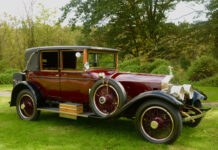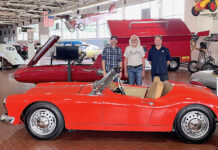By Jay Hirsch
Cadillac introduced the fin in 1948. It was nothing more than a gentle upward sloping of the rear fender in which the taillight rested. In 1957 Chrysler Corporation came out with their “Forward Look” in which their entire line-up of cars sported big graceful fins.
Cadillac which had introduced the tail fin could not sit idly by and be outdone by anyone. The result was the king of all tail fins on the 1959 Cadillac. The fins alone do not distinguish the 1959 Cadillac. It is the design of the fin, with those two bullet like taillights that protrude in each fin. The car epitomized the rocket-ship styling of the late 1950s American car. The Cadillac was a big car, 225 inches long, and it was powerful with an OHV 390 cid/6.4-liter engine under the hood that turned out 325 horsepower. This is a 5,000-pound car that could go from 0-60 mph in ten seconds, cruise all day at 75 to 80 mph with a top speed of 115 plus mph.
In the owner’s manual there is a paragraph regarding what to do when cruising at speeds over 75 mph for hours: “Inflate each tire to four to six pounds over the normal recommended inflation.”
The 1959 Caddy was not just a “pretty face,” it was a well-built car, a “tank” as many owners would say. The ride and quality were truly “The Standard of the World.”
 All Cadillac body styles in 1959, except for the series 75, were the “hardtop” or pillar-less design of the time period. This hardtop-design Cadillac was introduced in 1949 with their Coupe de Ville. The 1959 Cadillac line of cars had the two-door coupe, the six-window Fleetwood 60 Special sedan, the convertible, the series 75 Limousine, the four-door Eldorado Brougham, and the four- and six-window sedan. The four-window sedan was also called “the flat top” by many owners of the car.
All Cadillac body styles in 1959, except for the series 75, were the “hardtop” or pillar-less design of the time period. This hardtop-design Cadillac was introduced in 1949 with their Coupe de Ville. The 1959 Cadillac line of cars had the two-door coupe, the six-window Fleetwood 60 Special sedan, the convertible, the series 75 Limousine, the four-door Eldorado Brougham, and the four- and six-window sedan. The four-window sedan was also called “the flat top” by many owners of the car.
The four-window car seen here was bought new and has been in the same family ever since. The base price was $5,080, and with accessories and tax it came to $5970.73.
The original owners used the car on a weekly basis until the mid-1980s. It was then kept in the garage until 2011 when their grandson, Eric Del Santo, was given “custody” of the car.
Although the car had always been garaged, it was used year round, and if there was snow (and salt) on the road, the car was taken out. Then there was the matter of the garage it was in. The garage was separate from the house as many garages were when houses were built in the 1930s to 1950s. The garage roof had some leaks, which let water in, which settled on the car. This resulted in rust on areas on the roof and trunk as well as the front and rear bumpers. The interior had mildew and a strong musty odor. Even though the car had under 80,000 miles it was not in the best physical condition.
Eric has wanted the 1959 Caddy ever since he “was a kid.” It seems that his grandparents stopped driving the car because it needed some cosmetic work, which they never got around to doing. The car was originally dark gray with a matching gray interior. Eric never liked the color, saying “it was rather dull and too formal looking, not what a fun car should be.”
Eric had the bumpers and all chrome trim removed along with the interior and trunk lining. He then had a local body shop strip the car to bare metal, repair all rust damage and then paint the car. The body shop he used had done work on hot rods which was the primary reason Eric chose them.
“Doing work on rods, chopping the top, etc. some minor patch welding that the Caddy needed would be a piece of cake to them,” Eric said.
As for the blue color, Eric looked at several late model cars and saw a Toyota and a Land Rover in a blue he liked. He chose the Toyota blue. Whether by some “inner ghost” guiding him or a “higher being” whispering in his ear, the color Eric picked is very similar to a 1959 color that Cadillac offered named York Blue.
For the interior Eric went with a high-grade vinyl done in the same pattern as the original gray cloth. Eric went with vinyl for its durability and ease of maintenance. Eric and his wife want to drive and enjoy the car and did not want to have to tell their children “you cannot eat ice cream in the car!” If something spills on the seats, all they have to do is wipe it off. Leather being more costly and also involves much more upkeep.
Since the car was basically apart, Eric had the motor rebuilt, new water pump, radiator, heater core, etc. He also had the car’s braking system updated with a dual-master cylinder and a modern electronic ignition installed replacing the original “points and condenser.” The car now rides on 235/75 x 15 radial tires in place of the original 8.20 X 15 bias ply tires. The radials not only make for better ride and handling but also lower the car by about two inches, which gives it “a low and long look.”
The Cadillac four-window sedan was 54 inches tall, two inches lower than the six-window sedan, which made tail fins appear even higher than they really are. No where is this more dramatically seen than from the rear of the car. The fins seem almost as tall as the roof. That flat roof with its wrap around rear window affords 360-degree’s of visibility.
“When you see the end of that fin,” Eric said,“you know you have another inch before hitting what is behind the car, no rear view camera is needed.”
As for production totals, in 1959 the six-window won out over the four-window sedan with 42,619 six-window sedans sold and 26,446 four window’s built. The 12,250 Fleetwood 60 Special’s sold is not included in the six-window total. •



